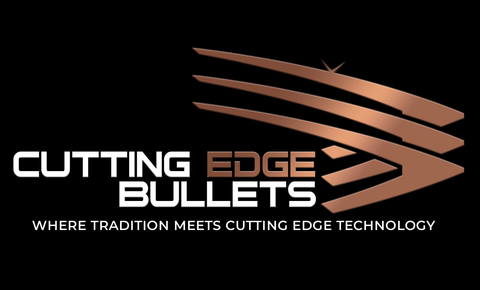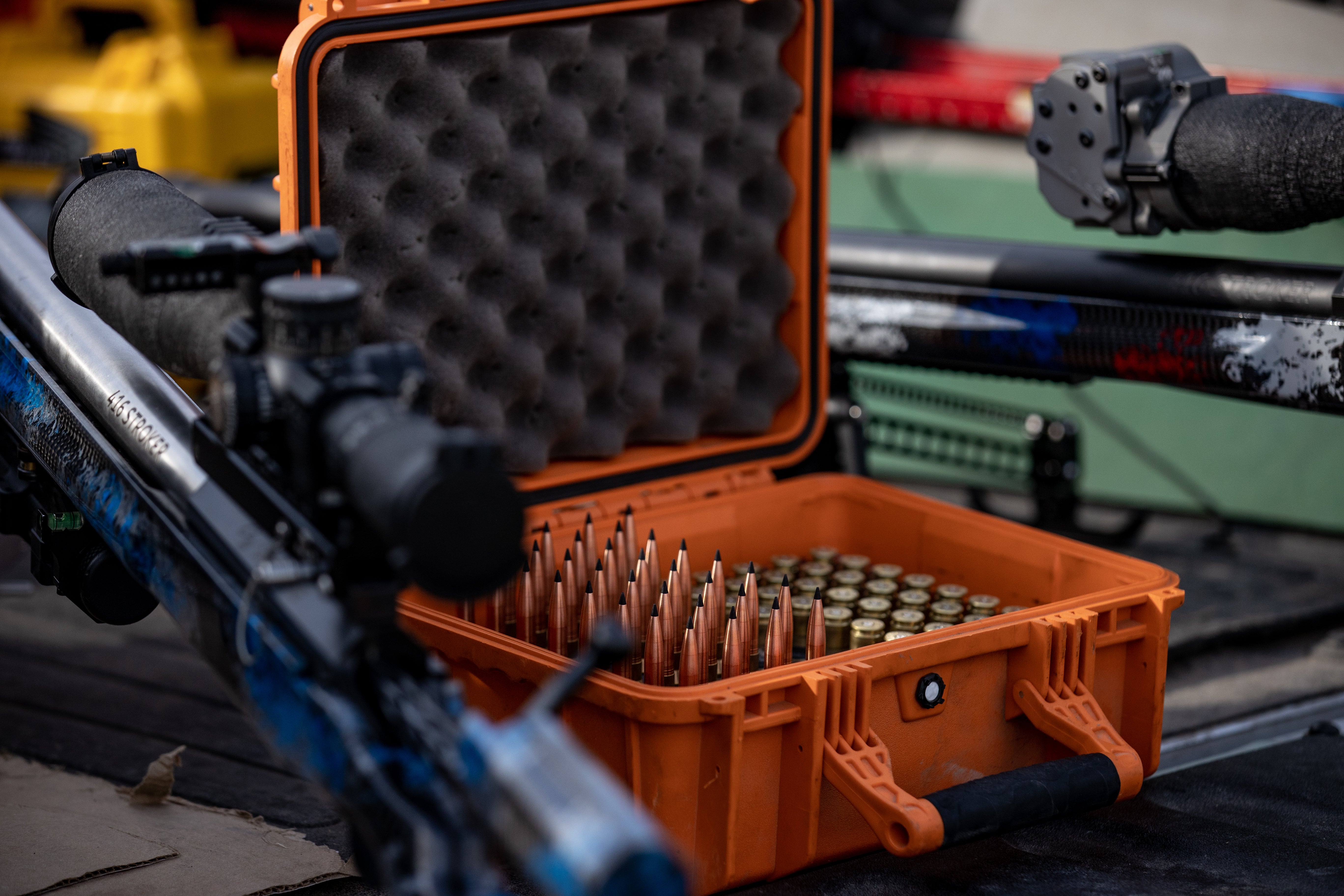The SealTite™ Band is unique to our solid copper bullets. It is the key to making our bullets fly without getting fliers common with some other solid copper or copper alloy bullets. It is larger than nominal caliber diameter by .0005" to .005" depending on caliber. This ensures there will be no pressure escaping around the bullet when fired. The STB position can be customized to allow for a different bullet projection length. There are however, limitations on how far forward the band can be positioned.
MDG or Material Displacement Grooves - The MDG serves two functions. One, it is a place for the material to flow into when the STB enters the throat and lands in the rifle barrel. This prevents excess pressure as the soft copper flows freely into them. Keep in mind we are talking about a very minimal amount of material that gets displaced. There is only .001 per side on diameter that is displaced which is approximately 1/3 the diameter of a human hair. They also acts as an indicator as to where the STB is actually at which is helpful for bullet seating.
Common Bullet Features
Meplat - Tip portion of a bullet. Meplat diameters of .17 calibers or less have been proven to have little effect on the ballistic coefficient of a bullet. There are some theories that suggest a small flat meplat with a hollow point actually creates lift and increases BC. We have seen neither increase nor any noticeable decrease between pointed bullets or ones with a small flat Meplat.
Ogive- Radius portion of a bullet that connects the body to the bullet nose, or meplat. There are several different types of ogives but the two most common types are the secant and the tangent. Secant ogives are typically found on VLD type bullets and are typically a larger radius that is not tangent, or smoothly connected, to the body of the bullet. Tangent ogives are typically a smaller radius than secant ogives but are smoothly connected to the body of the bullet. The larger the tangent ogive is the longer the bullet becomes especially from the tip to the body. This creates a problem especially for individuals using magazine fed rifles.
Bore Rider- Portion of the bullet from the ogive to the driving band that is slightly (.0001"-.0003") smaller than actual rifle bore size. Usually present on bullets designed for single shot rifles to allow maximum bullet projection for maximum charge capacity. It aids in aligning the bullet to the bore and prevents ogive contact with the lands when chambering bullets that protrude far out of a case.
Boat Tail- Rear tapered portion of a bullet intended for shooting further than 400 yards. It is useless under that yardage and flat base bullets are a better choice as they stabilize, or go to sleep, quicker than boat tailed bullets. At further distances however boat tails have a higher BC and retain their energy much better than flat base bullets. Boat tail bullets do not fully stabilize in less than 300 yards but may still group well. We recommend working up loads at over 250 yards for best long range performance.
Driving Band- Portion of the bullet that is between the SealTite™ band and bore rider or ogive. This portion of the bullet engages the lands, or rifling, ahead of the SealTite™ band and gets the bullet tracking true to the rifling before the SealTite™ band enter the lands. It is absolutely critical the bullet is tracking properly before SealTite™ band engages or "stripping" occurs and seal is lost. Our bullets are tested to ensure the driving band is long enough to ensure this does not happen. Since seal is not achieved with the driving band on our bullets its diameter is under nominal caliber diameter to prevent excess pressure. Caution! It is extremely important that if any individuals had a custom barrel made undersize, the driving band diameter must first be measured to ensure it is smaller than your groove diameter or you will get excess pressure. Solid copper does not give like lead core bullets and custom size barrel users must be very cautious. Any SAAMI spec. or factory rifle barrel will not have this problem. The Driving Band length can be customized to allow for more or less jump into the throat to bore angle.
MDG or Material Displacement Grooves - The MDG serves two functions. One, it is a place for the material to flow into when the STB enters the throat and lands in the rifle barrel. This prevents excess pressure as the soft copper flows freely into them. Keep in mind we are talking about a very minimal amount of material that gets displaced. There is only .001 per side on diameter that is displaced which is approximately 1/3 the diameter of a human hair. They also acts as an indicator as to where the STB is actually at which is helpful for bullet seating.
Common Bullet Features
Meplat - Tip portion of a bullet. Meplat diameters of .17 calibers or less have been proven to have little effect on the ballistic coefficient of a bullet. There are some theories that suggest a small flat meplat with a hollow point actually creates lift and increases BC. We have seen neither increase nor any noticeable decrease between pointed bullets or ones with a small flat Meplat.
Ogive- Radius portion of a bullet that connects the body to the bullet nose, or meplat. There are several different types of ogives but the two most common types are the secant and the tangent. Secant ogives are typically found on VLD type bullets and are typically a larger radius that is not tangent, or smoothly connected, to the body of the bullet. Tangent ogives are typically a smaller radius than secant ogives but are smoothly connected to the body of the bullet. The larger the tangent ogive is the longer the bullet becomes especially from the tip to the body. This creates a problem especially for individuals using magazine fed rifles.
Bore Rider- Portion of the bullet from the ogive to the driving band that is slightly (.0001"-.0003") smaller than actual rifle bore size. Usually present on bullets designed for single shot rifles to allow maximum bullet projection for maximum charge capacity. It aids in aligning the bullet to the bore and prevents ogive contact with the lands when chambering bullets that protrude far out of a case.
Boat Tail- Rear tapered portion of a bullet intended for shooting further than 400 yards. It is useless under that yardage and flat base bullets are a better choice as they stabilize, or go to sleep, quicker than boat tailed bullets. At further distances however boat tails have a higher BC and retain their energy much better than flat base bullets. Boat tail bullets do not fully stabilize in less than 300 yards but may still group well. We recommend working up loads at over 250 yards for best long range performance.
Driving Band- Portion of the bullet that is between the SealTite™ band and bore rider or ogive. This portion of the bullet engages the lands, or rifling, ahead of the SealTite™ band and gets the bullet tracking true to the rifling before the SealTite™ band enter the lands. It is absolutely critical the bullet is tracking properly before SealTite™ band engages or "stripping" occurs and seal is lost. Our bullets are tested to ensure the driving band is long enough to ensure this does not happen. Since seal is not achieved with the driving band on our bullets its diameter is under nominal caliber diameter to prevent excess pressure. Caution! It is extremely important that if any individuals had a custom barrel made undersize, the driving band diameter must first be measured to ensure it is smaller than your groove diameter or you will get excess pressure. Solid copper does not give like lead core bullets and custom size barrel users must be very cautious. Any SAAMI spec. or factory rifle barrel will not have this problem. The Driving Band length can be customized to allow for more or less jump into the throat to bore angle.

